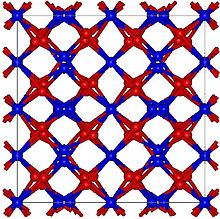
Back نتريد البيريليوم Arabic نیترید برلیوم AZB Berylliumnitrid Danish Berylliumnitrid German نیترید برلیم Persian Berylliumnitridi Finnish बेरिलियम नाइट्राइड Hindi Berillium-nitrid Hungarian Nitruro di berillio Italian 窒化ベリリウム Japanese

| |
| Names | |
|---|---|
| IUPAC name
Beryllium nitride
| |
| Other names
triberyllium dinitride
| |
| Identifiers | |
3D model (JSmol)
|
|
| ECHA InfoCard | 100.013.757 |
| EC Number |
|
| UNII | |
| |
| |
| Properties | |
| Be3N2 | |
| Molar mass | 55.051 g·mol−1 |
| Appearance | yellow or white powder |
| Density | 2.71 g/cm3 |
| Melting point | 2,200 °C (3,990 °F; 2,470 K) |
| Boiling point | 2,240 °C (4,060 °F; 2,510 K) (decomposes) |
| decomposes | |
| Solubility | decomposes in solutions of acid and base |
| Structure | |
| Cubic, cI80, SpaceGroup = Ia-3, No. 206 (α form) | |
| Hazards | |
| NIOSH (US health exposure limits): | |
PEL (Permissible)
|
TWA 0.002 mg/m3 C 0.005 mg/m3 (30 minutes), with a maximum peak of 0.025 mg/m3 (as Be)[1] |
REL (Recommended)
|
Ca C 0.0005 mg/m3 (as Be)[1] |
IDLH (Immediate danger)
|
Ca [4 mg/m3 (as Be)][1] |
| Related compounds | |
Other cations
|
Calcium nitride Magnesium nitride |
Except where otherwise noted, data are given for materials in their standard state (at 25 °C [77 °F], 100 kPa).
| |
Beryllium nitride, Be3N2, is a nitride of beryllium. It can be prepared from the elements at high temperature (1100–1500 °C);[2] unlike beryllium azide or BeN6, it decomposes in vacuum into beryllium and nitrogen.[2] It is readily hydrolysed forming beryllium hydroxide and ammonia.[2] It has two polymorphic forms cubic α-Be3N2 with a defect anti-fluorite structure, and hexagonal β-Be3N2.[2] It reacts with silicon nitride, Si3N4 in a stream of ammonia at 1800–1900 °C to form BeSiN2.[2]
© MMXXIII Rich X Search. We shall prevail. All rights reserved. Rich X Search